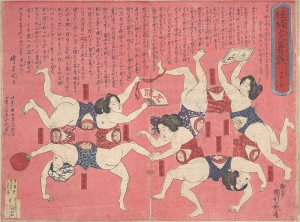By Helen King

(image courtesy of Archives and Special Collections, Library and Center for Knowledge Management, University of California, San Francisco)
Sometimes you come across an image that really sticks in your mind. I recently attended a workshop on the representation of the womb across time, and one of the papers introduced me to this striking image by Utagawa Kunitoshi, dated to 1881; at first the eye sees five pregnant women frolicking, but then you realise there are in fact ten, sharing heads. This means that there are a total of ten wombs, represented as transparent so that the viewer can see the various stages of pregnancy. And this is possibly the most amazing aspect of the image; because it means that this Japanese woodblock, created in 1881, seems to refer to a Western tradition of showing the fetus-in-utero that goes back to the Middle Ages.
Japanese medicine in this period mixed traditional and modern, Western and Eastern. In premodern Japan, the womb is not visualised in this way; one of the participants at the conference, Anna Andreeva, showed that illustrations of a pregnant woman in medical treatises would show the fetus vaguely placed in the belly, or linked to the right kidney, without a ‘womb’ shown. In the West, images of babies in the womb, in a variety of positions, seem to have originated in the 5th or 6th c AD work of the Latin writer Muscio, who worked in North Africa. From the 13th century, the sequence of images associated with Muscio – originally a total of 15, with a further image of twins added later – also turns up attached to the surgical writings of Albucasis, and then in various manuscripts of the 15th century. In these images, the womb is usually just a circle, or a jar shape, and there is normally no sign of the woman; the focus is on the babies, and the accompanying text describes the range of different ways in which a baby can present for birth. While Muscio’s text also included instructions on how to deal with difficult presentations, the images seem to have floated loose from the practical advice as the midwives to whom Muscio addressed his work increasingly ceased to have control over difficult births, and as Galenic medicine increased its dominance over Europe. But the babies in Kunitoshi’s image are not at full term, presenting in different positions; they appear to be normal babies, developing in a normal way.
But those transparent bellies of those playful Japanese women recall another feature of western European iconography; medieval images in which Mary, the mother of Jesus, meets Elizabeth, the mother of John the Baptist, and the artist shows the babies in the wombs of their respective mothers. As the women embrace each other, their unborn children greet each other.
While Japan in the Meiji era – the time of Kunitoshi – was welcoming western medicine and the modern illustrations from textbooks, and increasing state involvement in healthcare, the wombs of the playful pregnant women echo images from a much older western tradition. Were there any direct connections? Or did these transparent wombs arise spontaneously in this very different cultural context?
Further reading:
Monica H. Green, ‘The sources of Eucharius Roesslin’s “Rosegarden for Pregnant Women and Midwives” (1513)’, Medical History 53 (2009): 167-92: http://www.ncbi.nlm.nih.gov/pmc/articles/PMC2668903/pdf/medhis5302-01-167.pdf
Susan L. Burns, ‘The body in question: the politics and culture of medicine in Meiji Japan, 1868-1912’, Wellcome History 36 (2007): http://eprints.whiterose.ac.uk/64249/1/Wellcome_History_36_Winter_2007_.pdf
